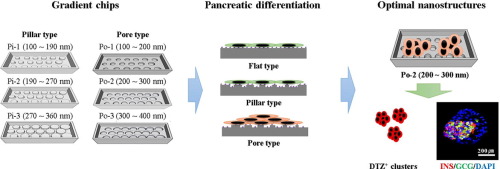当前位置:
X-MOL 学术
›
Acta Biomater.
›
论文详情
Our official English website, www.x-mol.net, welcomes your feedback! (Note: you will need to create a separate account there.)
Nanotopographical regulation of pancreatic islet-like cluster formation from human pluripotent stem cells using a gradient-pattern chip.
Acta Biomaterialia ( IF 9.7 ) Pub Date : 2018-12-06 , DOI: 10.1016/j.actbio.2018.12.011 Jong Hyun Kim 1 , Bo Gi Park 2 , Suel-Kee Kim 3 , Dong-Hyun Lee 2 , Gyung Gyu Lee 4 , Deok-Ho Kim 5 , Byung-Ok Choi 6 , Kyu Back Lee 2 , Jong-Hoon Kim 4
Acta Biomaterialia ( IF 9.7 ) Pub Date : 2018-12-06 , DOI: 10.1016/j.actbio.2018.12.011 Jong Hyun Kim 1 , Bo Gi Park 2 , Suel-Kee Kim 3 , Dong-Hyun Lee 2 , Gyung Gyu Lee 4 , Deok-Ho Kim 5 , Byung-Ok Choi 6 , Kyu Back Lee 2 , Jong-Hoon Kim 4
Affiliation

|
Bioengineering approaches to regulate stem cell fates aim to recapitulate the in vivo microenvironment. In recent years, manipulating the micro- and nano-scale topography of the stem cell niche has gained considerable interest for the purposes of controlling extrinsic mechanical cues to regulate stem cell fate and behavior in vitro. Here, we established an optimal nanotopographical system to improve 3-dimensional (3D) differentiation of pancreatic cells from human pluripotent stem cells (hPSCs) by testing gradient-pattern chips of nano-scale polystyrene surface structures with varying sizes and shapes. The optimal conditions for 3D differentiation of pancreatic cells were identified by assessing the expression of developmental regulators that are required for pancreatic islet development and maturation. Our results showed that the gradient chip of pore-part 2 (Po-2, 200-300 nm diameter) pattern was the most efficient setting to generate clusters of pancreatic endocrine progenitors (PDX1+ and NGN3+) compared to those of other pore diameters (Po-1, 100-200 or Po-3, 300-400 nm) tested across a range of pillar patterns and flat surfaces. Furthermore, the Po-2 gradient pattern-derived clusters generated islet-like 3D spheroids and tested positive for the zinc-chelating dye dithizone. The spheroids consisted of more than 30% CD200 + endocrine cells and also expressed NKX6.1 and NKX2.2. In addition, pancreatic β- cells expressing insulin and polyhormonal cells expressing both insulin and glucagon were obtained at the final stage of pancreatic differentiation. In conclusion, our data suggest that an optimal topographical structure for differentiation to specific cell types from hPSCs can be tested efficiently by using gradient-pattern chips designed with varying sizes and surfaces. STATEMENT OF SIGNIFICANCE: Our study provides demonstrates of using gradient nanopatterned chips for differentiation of pancreatic islet-like clusters. Gradient nanopatterned chips are consisted of two different shapes (nanopillar and nanopore) in three different ranges of nano sizes (100-200, 200-300, 300-400 nm). We found that optimal nanostructures for differentiation of pancreatic islet-like clusters were 200-300 nm nano pores. Cell transplantation is one of the major therapeutic option for type 1 diabetes mellitus (DM) using stem cell-derived β-like cells. We generated 50 um pancreatic islet-like clusters in size, which would be an optimal size for cell transplantation. Futuremore, the small clusters provide a powerful source for cell therapy. Our findings suggest gradient nanopatterned chip provides a powerful tool to generate specific functional cell types of a high purity for potential uses in cell therapy development.
中文翻译:

使用梯度模式芯片从人多能干细胞中形成胰岛样簇的纳米形貌调控。
调节干细胞命运的生物工程方法旨在概括体内微环境。近年来,操纵干细胞生态位的微尺度和纳米尺度的地形学已经引起了相当大的兴趣,以控制外部机械线索来调节体外干细胞的命运和行为。在这里,我们建立了一个最佳的纳米形貌系统,通过测试具有不同大小和形状的纳米级聚苯乙烯表面结构的梯度模式芯片,来改善胰腺细胞与人多能干细胞(hPSC)的3维(3D)分化。通过评估胰岛发育和成熟所需的发育调节剂的表达,确定了胰腺细胞3D分化的最佳条件。我们的结果表明,与其他孔径(Po)相比,第2部分(Po-2,直径200-300 nm直径)模式的梯度芯片是生成胰腺内分泌祖细胞(PDX1 +和NGN3 +)簇的最有效设置。 -1,100-200或Po-3,300-400 nm)在一系列柱状图案和平坦表面上进行了测试。此外,由Po-2梯度图案衍生的簇产生了类似胰岛的3D球体,并测试了锌螯合染料双硫zone的阳性结果。球体由30%以上的CD200 +内分泌细胞组成,还表达NKX6.1和NKX2.2。另外,在胰腺分化的最后阶段获得了表达胰岛素的胰β-细胞和同时表达胰岛素和胰高血糖素的多激素细胞。综上所述,我们的数据表明,可以通过使用具有不同大小和表面的梯度图案芯片来有效测试从hPSC分化为特定细胞类型的最佳拓扑结构。意义声明:我们的研究提供了使用梯度纳米图案芯片对胰岛样簇进行分化的证明。梯度纳米图案芯片由两种不同的形状(纳米柱和纳米孔)组成,具有三种不同的纳米尺寸范围(100-200、200-300、300-400 nm)。我们发现,用于区分胰岛样簇的最佳纳米结构是200-300 nm的纳米孔。使用干细胞衍生的β样细胞,细胞移植是1型糖尿病(DM)的主要治疗选择之一。我们产生了大小为50 um的胰岛样簇,这将是细胞移植的最佳尺寸。将来,小分子簇为细胞疗法提供了强大的资源。我们的研究结果表明,梯度纳米图案芯片可提供强大的工具来生成高纯度的特定功能细胞类型,以用于细胞疗法的开发。
更新日期:2019-08-23
中文翻译:

使用梯度模式芯片从人多能干细胞中形成胰岛样簇的纳米形貌调控。
调节干细胞命运的生物工程方法旨在概括体内微环境。近年来,操纵干细胞生态位的微尺度和纳米尺度的地形学已经引起了相当大的兴趣,以控制外部机械线索来调节体外干细胞的命运和行为。在这里,我们建立了一个最佳的纳米形貌系统,通过测试具有不同大小和形状的纳米级聚苯乙烯表面结构的梯度模式芯片,来改善胰腺细胞与人多能干细胞(hPSC)的3维(3D)分化。通过评估胰岛发育和成熟所需的发育调节剂的表达,确定了胰腺细胞3D分化的最佳条件。我们的结果表明,与其他孔径(Po)相比,第2部分(Po-2,直径200-300 nm直径)模式的梯度芯片是生成胰腺内分泌祖细胞(PDX1 +和NGN3 +)簇的最有效设置。 -1,100-200或Po-3,300-400 nm)在一系列柱状图案和平坦表面上进行了测试。此外,由Po-2梯度图案衍生的簇产生了类似胰岛的3D球体,并测试了锌螯合染料双硫zone的阳性结果。球体由30%以上的CD200 +内分泌细胞组成,还表达NKX6.1和NKX2.2。另外,在胰腺分化的最后阶段获得了表达胰岛素的胰β-细胞和同时表达胰岛素和胰高血糖素的多激素细胞。综上所述,我们的数据表明,可以通过使用具有不同大小和表面的梯度图案芯片来有效测试从hPSC分化为特定细胞类型的最佳拓扑结构。意义声明:我们的研究提供了使用梯度纳米图案芯片对胰岛样簇进行分化的证明。梯度纳米图案芯片由两种不同的形状(纳米柱和纳米孔)组成,具有三种不同的纳米尺寸范围(100-200、200-300、300-400 nm)。我们发现,用于区分胰岛样簇的最佳纳米结构是200-300 nm的纳米孔。使用干细胞衍生的β样细胞,细胞移植是1型糖尿病(DM)的主要治疗选择之一。我们产生了大小为50 um的胰岛样簇,这将是细胞移植的最佳尺寸。将来,小分子簇为细胞疗法提供了强大的资源。我们的研究结果表明,梯度纳米图案芯片可提供强大的工具来生成高纯度的特定功能细胞类型,以用于细胞疗法的开发。



























 京公网安备 11010802027423号
京公网安备 11010802027423号